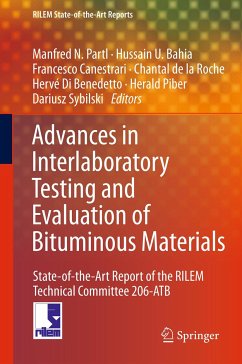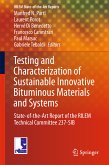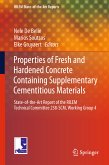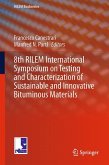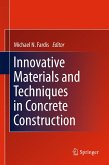Advances in Interlaboratory Testing and Evaluation of Bituminous Materials (eBook, PDF)
State-of-the-Art Report of the RILEM Technical Committee 206-ATB
Redaktion: Partl, Manfred N.; Sybilski, Dariusz; Piber, Herald; Di Benedetto, Hervé; de la Roche, Chantal; Canestrari, Francesco; Bahia, Hussain U.
72,95 €
72,95 €
inkl. MwSt.
Sofort per Download lieferbar

36 °P sammeln
72,95 €
Als Download kaufen

72,95 €
inkl. MwSt.
Sofort per Download lieferbar

36 °P sammeln
Jetzt verschenken
Alle Infos zum eBook verschenken
72,95 €
inkl. MwSt.
Sofort per Download lieferbar
Alle Infos zum eBook verschenken

36 °P sammeln
Advances in Interlaboratory Testing and Evaluation of Bituminous Materials (eBook, PDF)
State-of-the-Art Report of the RILEM Technical Committee 206-ATB
Redaktion: Partl, Manfred N.; Sybilski, Dariusz; Piber, Herald; Di Benedetto, Hervé; de la Roche, Chantal; Canestrari, Francesco; Bahia, Hussain U.
- Format: PDF
- Merkliste
- Auf die Merkliste
- Bewerten Bewerten
- Teilen
- Produkt teilen
- Produkterinnerung
- Produkterinnerung

Bitte loggen Sie sich zunächst in Ihr Kundenkonto ein oder registrieren Sie sich bei
bücher.de, um das eBook-Abo tolino select nutzen zu können.
Hier können Sie sich einloggen
Hier können Sie sich einloggen
Sie sind bereits eingeloggt. Klicken Sie auf 2. tolino select Abo, um fortzufahren.

Bitte loggen Sie sich zunächst in Ihr Kundenkonto ein oder registrieren Sie sich bei bücher.de, um das eBook-Abo tolino select nutzen zu können.
Unique data collection as research basis
Unique summary of state of the art
Practical recommendations, tips & guidelines for researchers on how to conduct comparative interlaboratory tests (with examples)
Practical info for quality assurance & standardization
This information comprises bituminous binder and mixture tests
- Geräte: PC
- ohne Kopierschutz
- eBook Hilfe
- Größe: 18.39MB
Andere Kunden interessierten sich auch für
![Testing and Characterization of Sustainable Innovative Bituminous Materials and Systems (eBook, PDF) Testing and Characterization of Sustainable Innovative Bituminous Materials and Systems (eBook, PDF)]() Testing and Characterization of Sustainable Innovative Bituminous Materials and Systems (eBook, PDF)128,95 €
Testing and Characterization of Sustainable Innovative Bituminous Materials and Systems (eBook, PDF)128,95 €![Modeling and Design of Flexible Pavements and Materials (eBook, PDF) Modeling and Design of Flexible Pavements and Materials (eBook, PDF)]() Dallas N. LittleModeling and Design of Flexible Pavements and Materials (eBook, PDF)68,95 €
Dallas N. LittleModeling and Design of Flexible Pavements and Materials (eBook, PDF)68,95 €![Properties of Fresh and Hardened Concrete Containing Supplementary Cementitious Materials (eBook, PDF) Properties of Fresh and Hardened Concrete Containing Supplementary Cementitious Materials (eBook, PDF)]() Properties of Fresh and Hardened Concrete Containing Supplementary Cementitious Materials (eBook, PDF)112,95 €
Properties of Fresh and Hardened Concrete Containing Supplementary Cementitious Materials (eBook, PDF)112,95 €![8th RILEM International Symposium on Testing and Characterization of Sustainable and Innovative Bituminous Materials (eBook, PDF) 8th RILEM International Symposium on Testing and Characterization of Sustainable and Innovative Bituminous Materials (eBook, PDF)]() 8th RILEM International Symposium on Testing and Characterization of Sustainable and Innovative Bituminous Materials (eBook, PDF)160,95 €
8th RILEM International Symposium on Testing and Characterization of Sustainable and Innovative Bituminous Materials (eBook, PDF)160,95 €![Strain-Hardening Cement-Based Composites (eBook, PDF) Strain-Hardening Cement-Based Composites (eBook, PDF)]() Strain-Hardening Cement-Based Composites (eBook, PDF)160,95 €
Strain-Hardening Cement-Based Composites (eBook, PDF)160,95 €![Innovative Materials and Techniques in Concrete Construction (eBook, PDF) Innovative Materials and Techniques in Concrete Construction (eBook, PDF)]() Innovative Materials and Techniques in Concrete Construction (eBook, PDF)160,95 €
Innovative Materials and Techniques in Concrete Construction (eBook, PDF)160,95 €![Nondestructive Testing of Materials and Structures (eBook, PDF) Nondestructive Testing of Materials and Structures (eBook, PDF)]() Oral BüyüköztürkNondestructive Testing of Materials and Structures (eBook, PDF)432,95 €
Oral BüyüköztürkNondestructive Testing of Materials and Structures (eBook, PDF)432,95 €-
-
-
Unique data collection as research basis
Unique summary of state of the art
Practical recommendations, tips & guidelines for researchers on how to conduct comparative interlaboratory tests (with examples)
Practical info for quality assurance & standardization
This information comprises bituminous binder and mixture tests
Unique summary of state of the art
Practical recommendations, tips & guidelines for researchers on how to conduct comparative interlaboratory tests (with examples)
Practical info for quality assurance & standardization
This information comprises bituminous binder and mixture tests
Dieser Download kann aus rechtlichen Gründen nur mit Rechnungsadresse in A, B, BG, CY, CZ, D, DK, EW, E, FIN, F, GR, HR, H, IRL, I, LT, L, LR, M, NL, PL, P, R, S, SLO, SK ausgeliefert werden.
Produktdetails
- Produktdetails
- Verlag: Springer Netherlands
- Seitenzahl: 453
- Erscheinungstermin: 17. Oktober 2012
- Englisch
- ISBN-13: 9789400751040
- Artikelnr.: 37805809
- Verlag: Springer Netherlands
- Seitenzahl: 453
- Erscheinungstermin: 17. Oktober 2012
- Englisch
- ISBN-13: 9789400751040
- Artikelnr.: 37805809
- Herstellerkennzeichnung Die Herstellerinformationen sind derzeit nicht verfügbar.
Preface.- Acknowledgement (Participating Experts and Laboratories).- 1. Introduction, by Partl et al: Background of RILEM interlaboratory tests.- Methodology for testing of bituminous pavement materials principles - basic elements of a testing framework.- Principles for planning interlaboratory tests.- References.- 2. Binder Testing, by Sybilski et al: Bituminous binder fatigue testing: State-of-the-art.- Binder fatigue properties and the results of the RILEM round robin test.- Test description: RILEM binder fatigue test.- References.- 3. Mixture Design and Compaction, by Bahia et al: Background.- Mixture design methods.- Hot mix asphalt image acquisition, processing, and analysis procedures.- Effect of compaction methods on internal structure and air void distribution of asphalt mixture.- RILEM TG2 group study on internal aggregate structure of hot mix asphalt.- Concluding remarks.- References.- 4. Mechanical Testing of Bituminous Mixtures, by Di Benedetto et al: Introduction.- Wheel tracking tests (WTT) campaigns on mixtures made with pure and modified bitumen.- Modeling and finite elements calculation.- References.- 5. Interlaboratory Tests on Pavement Performance Prediction and Evaluation - Rutting, by Piber et al: Introduction.- Pavement of the test section.- Rutting measurements and predictions by the laboratories.- Field measurements and data collection by the road operator.- Data evaluation.- Conclusions.- References.- 6. Mechanical Testing of Interlayer Bonding in Asphalt Pavements, by Canestrari et al.: Overview on interlayer bonding in asphalt pavements.- Inter-laboratory test on interlayer bonding of asphalt pavements.- Conclusions.- References.- 7. Hot Recycling of Bituminous Mixtures, by DeLaRoche et al: Introduction.- Use of reclaimed asphalt in Europe.- Development of a laboratory aging protocol for bituminous mixtures.- Organisation of round robin test.- Results of round robin test.- Conclusions and recommendations on laboratory ageing of bituminous mixtures.- References.- Annex: Principle of infrared spectroscopy.- 8. General Summary and Outlook, by Chailleux et al: Introduction.- RILEM technical committee summary and feedback.- RILEM technical committee outlook.- Concluding remarks.- References.- Index.
Preface.- Acknowledgement (Participating Experts and Laboratories).- 1. Introduction, by Partl et al: Background of RILEM interlaboratory tests.- Methodology for testing of bituminous pavement materials principles - basic elements of a testing framework.- Principles for planning interlaboratory tests.- References.- 2. Binder Testing, by Sybilski et al: Bituminous binder fatigue testing: State-of-the-art.- Binder fatigue properties and the results of the RILEM round robin test.- Test description: RILEM binder fatigue test.- References.- 3. Mixture Design and Compaction, by Bahia et al: Background.- Mixture design methods.- Hot mix asphalt image acquisition, processing, and analysis procedures.- Effect of compaction methods on internal structure and air void distribution of asphalt mixture.- RILEM TG2 group study on internal aggregate structure of hot mix asphalt.- Concluding remarks.- References.- 4. Mechanical Testing of Bituminous Mixtures, by Di Benedetto et al: Introduction.- Wheel tracking tests (WTT) campaigns on mixtures made with pure and modified bitumen.- Modeling and finite elements calculation.- References.- 5. Interlaboratory Tests on Pavement Performance Prediction and Evaluation - Rutting, by Piber et al: Introduction.- Pavement of the test section.- Rutting measurements and predictions by the laboratories.- Field measurements and data collection by the road operator.- Data evaluation.- Conclusions.- References.- 6. Mechanical Testing of Interlayer Bonding in Asphalt Pavements, by Canestrari et al.: Overview on interlayer bonding in asphalt pavements.- Inter-laboratory test on interlayer bonding of asphalt pavements.- Conclusions.- References.- 7. Hot Recycling of Bituminous Mixtures, by DeLaRoche et al: Introduction.- Use of reclaimed asphalt in Europe.- Development of a laboratory aging protocol for bituminous mixtures.- Organisation of round robin test.- Results of round robin test.- Conclusions and recommendations on laboratory ageing of bituminous mixtures.- References.- Annex: Principle of infrared spectroscopy.- 8. General Summary and Outlook, by Chailleux et al: Introduction.- RILEM technical committee summary and feedback.- RILEM technical committee outlook.- Concluding remarks.- References.- Index.
